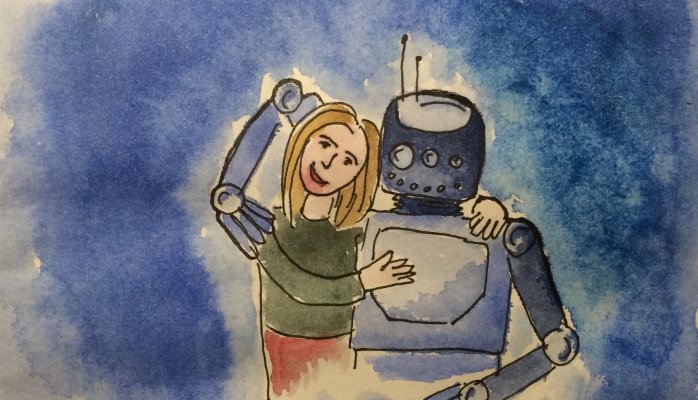We live in exciting times of new technologies and innovative products, but one of the most uncertain issues of today is the future of jobs. Already many kinds of jobs have been automated to some extent and there is a risk of employment going down in various segments of the labor market. This is not only in manual labor, but also in service industries, from travel agencies to accountancy. The development of disruptive technologies, such as sensor technologies, data processing and battery technology, is accelerating and become affordable for all kinds of robots, including the digital assistants on your smart phone. It’s easy to see how self-driving cars could take us to a future of less car ownership and safer, more efficient transport. Already, everyone can buy a drone and it feels like a matter of time before we see robots sitting next to us in the office. Will most of us lose our jobs or will there be other kinds of jobs that require other skillsets? Or to reframe it differently, would we be finally working less hours and have more spare time?
Tech forecasting and foresight
While technology trends are –to some extent- fairly predictable, societal change and the use of technology far less. Who had predicted the sharing economy in the late nineties? Didn’t Back to the Future miss out on the internet and how that changed society? Besides that, turbulence and volatility in the economy and oil prices, uncertainty in geo-politics, climate change and many other things, all make our future less predictable than trend forecasters wish you to believe.
Scenario planning
This is where scenario planning can help to get a better understanding of change and what this could mean for the future of jobs. Scenario planning is a systematic approach to consider multiple futures as alternative systems of where the world might be in the future. Scenarios are storylines and as such not intended to be truthful and predictive, but they depict a systems view that sharpens our intuition and imagination of what may happen in the future. Scenarios help to reframe the signals of change and understand them in the light of the future in ten or twenty years time. While scenario planning is really a social learning experience, let’s take a look here of where this type of thinking would take us in the future of jobs and the rise of robotized work.
Scenario planning highlights meaningful stories of the future. Stories that are already ‘in the air’ and some of it we already see today. Through group sessions, interviews and literature studies, these are shaped and crafted into a set of alternative futures that are relevant for decision making and challenging people’s baseline understanding of the future. Some archetypes of system descriptions are returning in many scenario projects, even though specific matters can give a different twist to the storyline.
Three archetype scenarios
One recurrent system description displays a super-efficient global system. Technologies have helped to reduce transaction costs, create adaptable, on-demand production chains for everything, and low prices to boost the economy. New technologies have created more sustainable energy and food systems, which reduces the pressures of climate change. Another recurrent system description recognizes the importance of locally connected systems, metropolitan or regional cultures. People value craftsmanship and small-scale locally produced goods as they shape our identity. There is an emphasis on participation in networks and working together on open source technologies to develop fair and sustainable innovations. A third recurrent system description can be seen as a variant, or in between version of the other two. One main difference is the role of values and different ethics between regions. In one region, people may embrace the use of robots fully and they take over human roles in many professions. In other regions, people refuse to deal with robots in situations where they appreciate a human touch. This creates a world with different technology frontiers. Some regions will stimulate technology developments much more than others.
These are only the beginning of scenario descriptions. Nothing more than the basic structure. It needs group sessions to develop the storyline and a more elaborated system description to create proper scenarios and be useful in supporting strategic decision making. However, even from these archetypes we can try to say something about the future of jobs and robotics in addition to what we can learn from technology forecasters.
Future of jobs in the light of these scenario archetypes
The super-efficient scenario is showing us a world where ‘winner takes all’ technology is applied globally. In this future, sself-driving cars have been the end to traffic jams and the streets have never been safer. Consumer goods have become cheaper and maybe the automated work has freed up our time to do meaningful things, such as caring roles or creative hobbies. New jobs could be in training and coaching. In the locally connected world we appreciate how technology can help us, but we also value the human touch, the handcrafted feel and even the flaws that only the human hand can produce. People spend money on products with personality, even if mass production is cheaper. Personal trainers, service and hospitality staff are the indispensable human contact that makes us feel at ease and triggers positive behaviors. The value based future tells us that cultures differ in how much they welcome technology in their lives. That means, the examples of robots in Japan may not be the forebode of the role of robots everywhere.
What these examples could tell us about the role of robots in the future, it that we may indeed see robot technology help to create more efficient, low cost systems. But on the other hand, the human touch cannot be replaced completely. That means, human jobs will not only be in the high-end creative and craft sectors. Wherever the human touch is needed, only part of the job can be automated. Robots in the classroom can play with kids and practice their exercises (while the teacher takes a break). Only the teacher can tell a story while connecting with the individual kids and build relationships that facilitate their learning. Robots can do many care taking jobs for the elderly, but only a friend or family member can hold hands and tell them to be there for them. Video cameras can identify early warnings of riots and social unrest, but only humans can make people calm down. While we can do our things in an automated environment pretty well, we need the human touch in all facets of life.
Scenarios as a toolbox for new ideas and opportunities
In scenario planning, we use the reframing of the future to find new solution spaces. With real scenarios for a specific domain tailored to the strategic questions of an organization, you could dig deeper in finding emerging opportunities that open up in each of the scenarios. My examples are only a bit of dry swimming without going through the social learning process. Trough conversation, different minds come together, create new ideas, and gain insight about emerging jobs and new skillsets for the jobs of the future. Systematically considering the consequences is the next step in being prepared for the future. Scenarios are a very powerful tool to look beyond the tech forecasts and find out how the future of work is shifting in face of the automation trends.


